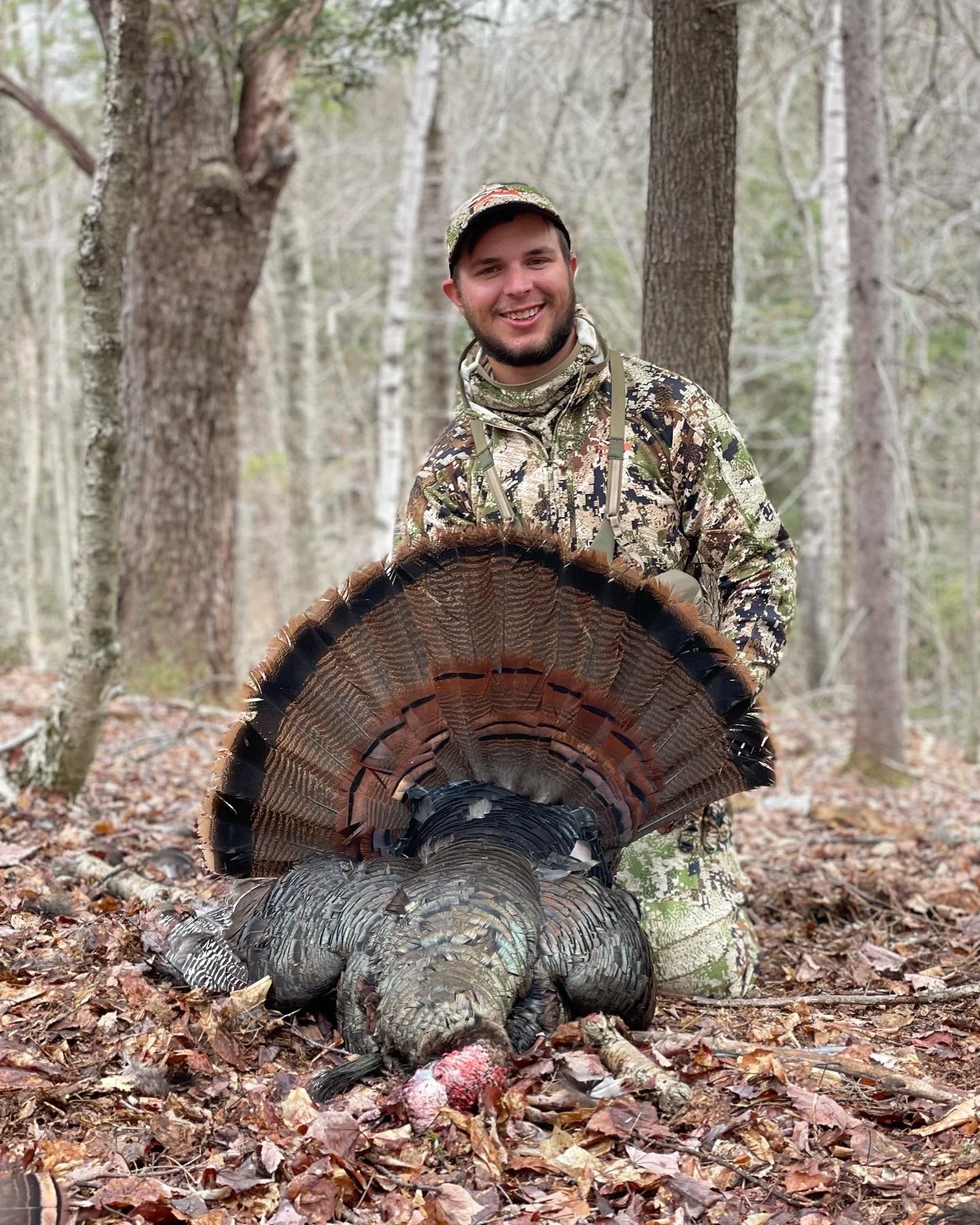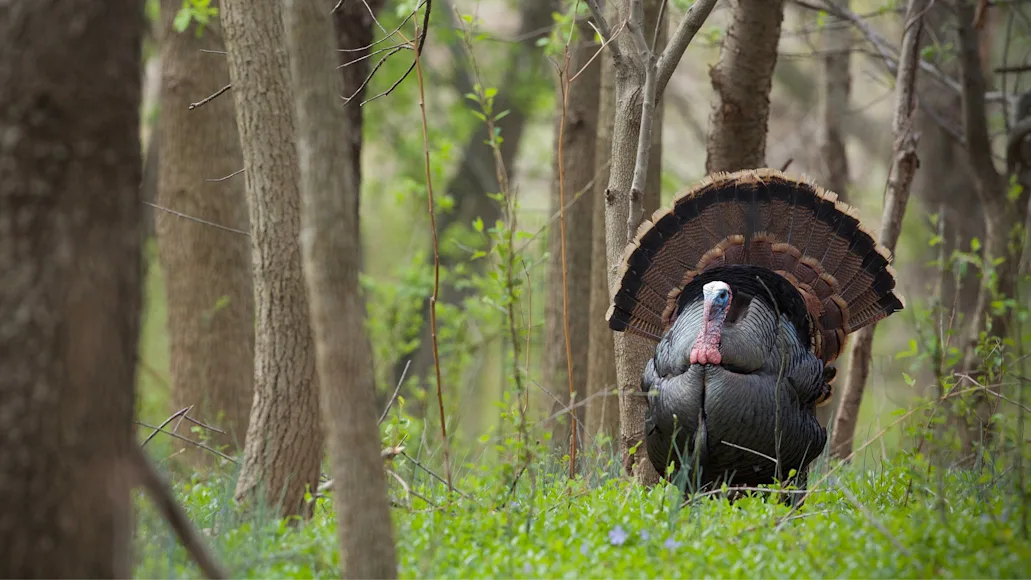The eastern wild turkey is North America's most abundant and widely distributed turkey subspecies. It inhabits 38 states and a handful of Canadian provinces. Most eastern turkeys are found east of the Mississippi River, but some extend beyond it in certain areas. Due to their large population and distribution, hunters can find gobblers on public land all across the East and Midwest. However, these birds are known for being wary and hard to call into range.
Currently, eastern turkey populations are declining in some southeast and midwest states. Biologists are working hard to determine the reasons for the dip in numbers, but there are still plenty of excellent eastern turkey hunting opportunities throughout the country. If you’re new to turkeys and turkey hunting, this general guide will walk you through identification, population status, hunting tactics, and cooking tips for the king of longbeards.

Appearance
Overall, the eastern gobbler is dark, almost appearing black at a distance. Up close, toms feature beautiful dark brown or chestnut tail feathers, giving way to slightly softer (lighter) tail tips above a solid black band. Eastern toms are known for their long, thick, bushy beards and sharp-tipped spurs, often measuring an inch or more. Typical eastern gobblers weigh anywhere from 18 to 24 pounds. However, some big toms can push or even exceed 30 pounds. Hens are much lighter, weighing an average of 10 to 12 pounds.
Toms are known to gobble frequently, especially in the spring when they’re trying to locate hens. Eastern gobblers are loud, too. In fact, they are louder than any other subspecies of turkey. Like Merriam’s, Rio’s, and Osceola’s, the eastern sports black-and-white wing feathers. However, eastern turkeys contain much more white on the wing than the Osceola.
As mentioned, hen eastern turkeys are considerably smaller than the toms and overall a muted brown. They lack the vibrant red-white-blue head and heavy snood (which hangs down above a gobbler’s beak) of the tom, though some hens will sport small wispy beards. Some females are known to go into full strut, which is thought to demonstrate or remind them of their hierarchy within the flock.
Range and Habitat
The eastern wild turkey ranges from roughly east Texas due north to western Minnesota and from that line throughout the entire eastern U.S., with the exception of central and southern Florida, where the Osceola turkey makes its home. Eastern wild turkeys are the most widely distributed subspecies of the four, with populations found as far away as western Washington state and the lands surrounding Dworshak Reservoir in western Idaho.
At one time, wildlife biologists were under the impression that eastern turkeys needed some 10,000 contiguous acres of forestland to survive and propagate. However, it’s been determined that the eastern turkey is a bird of mixed habitats, doing quite well in areas where timber meets traditional uplands with agricultural fields nearby.

Population Status
Eastern turkey populations, though still stable and even increasing in parts of its range, are a species of biological concern in some areas. This concern is particularly noteworthy in the southeastern and southern U.S. and in states like Mississippi, Alabama, Georgia, and Arkansas. Some of these places have seen their eastern wild turkey populations falter by as much as 50 percent. Even states like Missouri and Iowa, long considered strongholds of eastern turkeys, have begun to experience declines in population.
Wildlife managers are still trying to determine why eastern turkey populations are declining in certain areas. Steps are being taken to better understand the decline and, once armed with that knowledge, slow or even stop it. The Southeast Regional Wild Turkey Reproductive Decline Study, a cooperative effort comprised of 15 states and captained by Dr. Michael Chamberlain, a wildlife ecology and management professor at The University of Georgia, is currently researching the decline in turkey populations throughout the Southeast. Our own hunting editor has also given his takeaways from recent turkey seasons.
3 Hunting Tips for Eastern Wild Turkeys
Many say that eastern gobblers are the toughest to call into range, which may be a result of the hunting pressure throughout the years. They have a reputation for ignoring calls, coming in silently, leaving the same way, and hanging up just outside of gun range while gobbling their head off. These birds are a challenge to hunt, but offer an exciting experience that includes communication between the turkey and the hunters. Here are four tips to help you get off on the right foot while hunting eastern wild turkeys.

Pattern Your Shotgun
When it comes to patterning my turkey hunting shotgun, I have one simple rule: know what the shotgun does every time I pull the trigger. This means spending time at the range shooting any number of shotshells, shot sizes, and choke combinations until you find your ideal pattern. In addition, know how your gun patterns at 10 yards, 20 yards, 30 yards, 40 yards, and 45-plus yards for those shooting tungsten loads. Learn how to pattern your shotgun so you’re confident in your gun’s ability in the field.
Scouting
Locating a gobbler is half the battle, but good preseason scouting can set you up for success. During the winter, turkeys will group up into big flocks, and if you find them, you can better understand the birds in your area, including flock numbers, gobbler-to-hen ratios, and more. In the field, look for good turkey habitat, which is a mixture of wooded areas, cut forests, and agricultural fields. Also, look for scratchings in the field, which consist of a small cleared area of the ground that turkeys make to look for food. As it gets closer to the season, use your ears and try to roost birds. If you find where a turkey sleeps, there’s a good chance you can sneak in close the next day.
Calling
Learning how to successfully call in turkeys takes a lot of time, experience, and practice. And there’s no better place to learn than talking to a real gobbler. That said, you can start by picking up some of the best turkey calls and reading about calling tips/tactics from our experts.
Cooking Tips for Eastern Wild Turkeys
Roasting a wild turkey whole is an excellent way to prepare your spring harvest. However, it’s important to remember that wild turkeys work for a living and don’t have the fat a Butterball or Jennie-O does. That said, season your dressed bird with salt, pepper, garlic, and sage, slip it into a roasting bag, and then into the oven at 350 degrees for three to four hours (depending on the weight). If you’re looking for something else, try out one of these seven great wild turkey recipes.


